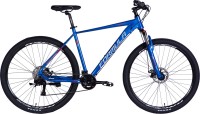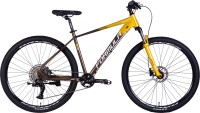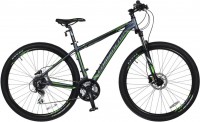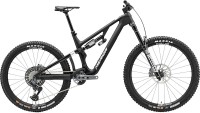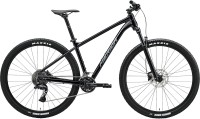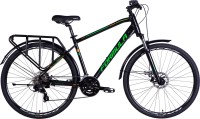Types of suspension forks
We independently test the products and technologies that we recommend.

How suspension forks work
The main goal of a suspension system is to absorb road bumps, which involves three key characteristics: Preload (adjusting initial tension), Rebound (controlling return speed), and Compression (managing compression speed). Different suspension fork types may require specific settings, and all parameters should be tailored to the user's weight, riding style, and the terrain they encounter.
Preload is responsible for the level of sag (moving of fork) when hitting bumps. In fact, the stiffness of the spring is changed with the help of a regulator. This setting is found on most branded suspension forks starting at $50.
 |
Large travel in suspension forks is ideal for tackling challenging terrains with deep holes, high curbs, and landing after jumps. On the other hand, a small travel is more suitable for providing comfort on roads with numerous small obstacles like bulldozer tracks or high-tread production machines. However, achieving optimal performance requires the right combination of travel and rebound tuning.
Rebound is responsible for the speed of the return of the fork to its normal position and its ability to again soften the next obstacle. This allows you to keep control of the bike at the time of overcoming a large number of bumps.
 |
Depending on the type of fork, different rebound principles can be applied based on elastomer, air or oil. The material used for adjustment is called a damper. On small and frequent obstacles, it works out a quick rebound better. For dynamic driving in deep pits, a slow rebound is necessary, as a sharp reverse bounce after a strong compression can lead to loss of control.
The compression setting of the spring allows precise adjustment of the damping system to the terrain. It involves two concepts — Low-speed compression for softer and slower travel, suitable for climbing hills, navigating small obstacles, or riding on flat roads. High-speed compression is designed for extreme driving with increased loads, like overcoming large pits and jumps, but it's rarely used in practice.
 |
The LockOut mode, also known as blocking, completely locks the fork's travel. This feature is useful for achieving high speed while climbing uphill or riding on smooth asphalt. By preventing any suspension movement, it eliminates unnecessary bouncing and significantly improves acceleration and peak speed.
 |
Variety of suspension forks
Depending on the purpose and price category of the bike, the following types of forks can be installed:
It's important to mention the concept of a spring fork, which uses two stiff springs. However, this approach proved to be inefficient and is rarely used, even in low-cost bikes. For the following discussion, we will focus on high-quality suspension forks that are recommended for both amateurs and professionals.
Spring-elastomer
An entry-level fork commonly found on low-cost mountain bikes uses a steel spring as the shock absorber and an elastomer, typically a rubber "sausage" inside the spring, as the damper.
 |
The effectiveness of the spring-elastomer suspension system is minimal. While it can smooth out large bumps, it is not effective at handling small obstacles. This type of fork lacks rich settings, with only Preload available in mid-price and premium models. Rebound and Compression settings are missing. It is more suitable for riding on rough terrain without engaging in extreme sports. It can also be used for urban rides, improving curb maneuverability, but classic city bikes are often equipped with rigid forks that do not have shock absorption.
One drawback of the spring-elastomer suspension system is its declining effectiveness over time due to factors like dust, water, and physical wear of the elastomer. In colder temperatures, the efficiency is greatly reduced as the rubber becomes harder. On the positive side, this type of fork offers low cost, easy cleaning, maintenance, and replacement options.
Spring-oil
The spring and oil cartridge system is widely popular among both amateurs and professionals because of its affordability and extensive variety. This setup offers high efficiency by allowing users to adjust the fork's travel through compression of the spring. The oil cartridge acts as the damper, enabling adjustments to the rebound speed or complete lockout for track riding. Different models may have various settings to cater to individual preferences.
 |
Spring-oil forks are highly effective for off-road riding, making them a popular choice for various mountain bike disciplines like freeride, enduro, downhill, cross-country. They are also well-suited for recreational rough terrain exploration such as country roads and forest trails. If low-cost allows, these forks can provide maximum comfort for city commuting as well, making them a versatile option for both enthusiasts and casual riders.
While having adjustable settings in spring-oil forks is advantageous, it can be challenging for beginners to understand and adjust them properly. Additionally, maintaining, repairing, or replacing the oil cartridge can be costly. Regular seasonal oil changes might be necessary since oil viscosity and properties vary with air temperature.
Air-oil
The most expensive and technically advanced suspension fork consists of two chambers - oil and air. The oil chamber acts as the damper, similar to the spring-oil type, while the high-pressure air chamber provides shock absorption. Maintaining this fork requires specialized knowledge, experience, and equipment, making it suitable for professional use in competitions. Extreme sports enthusiasts also use it for freeride races on difficult tracks.
 |
The air-oil fork offers precise customization for both the rider and terrain conditions. However, its maintenance can be expensive as cuffs and seals wear out quickly due to the loads, potentially leading to air leakage. Releasing some air can reduce pressure and make the shock absorber softer, but adjusting stiffness requires a high-pressure pump, making on-the-road adjustments impractical. If the fork sustains physical damage, replacing it can cost 20 — 35% of the bike's total cost.
Service recommendations
Each type of fork has distinct design characteristics, and their maintenance requirements vary. Spring-elastomer forks are more vulnerable to dust, dirt, and water, which can diminish their shock-absorbing capabilities. To maintain their performance, it's essential to clean and lubricate components like sliders, stanchions, spring, and damper twice a year, especially if used year-round. Teflon and silicone lubricants are suitable for this purpose. Additionally, during maintenance, it's crucial to inspect the integrity of the dust seals and replace them when necessary.
Air-oil and spring-oil forks are known for their better sealing and protection against external contaminants. However, due to the demanding nature of their use, it is advisable to perform annual maintenance, including the replacement of oil seals, seals, and dust seals.
After maintenance, it's crucial to conduct a test drive and fine-tune the fork to eliminate any play or issues that may arise during the ride. If there is any degradation in performance, squeaking, bumping, oil leaks, or air leakage, it's essential to perform unscheduled servicing promptly. Delaying repairs can lead to costly and extensive repairs later on.
Conclusions
You need to decide on the type of suspension fork at the stage of choosing a bike. The purpose of the fork must match the purpose of the bike. It's pretty silly to put an expensive air/oil fork on a low-cost mountain bike that won't stand up to even the simplest of tests.
In urban cycling, suspension is often not necessary since there are minimal obstacles, typically limited to curbs that can be easily handled even with a basic spring-elastomer fork. To avoid unnecessary maintenance, many urban cyclists opt for rigid forks without any cushioning.
Spring-oil suspension forks are versatile and widely used due to their diverse range of options across various price categories. They offer a good assortment of settings, allowing users to adapt them to different riding conditions. These forks cater to the needs of beginners, amateurs, and professionals, as they can handle off-road challenges, help professionals in competition preparation, and provide added comfort in city commuting. However, it's important to note that they require pre-configuration for specific terrain, making them suitable for more focused and consistent tasks.
For extreme sports, an air-oil fork will be the most suitable. It covers a number of disciplines — cross-country, downhill, freeride, enduro. The difference is only in the design and capabilities. You can find options for competitions and amateur descents along the most sophisticated mountain slopes. It is not advisable to use a fork for simple rides, since its setup and maintenance will cause a stupor in any beginner, and the cost sometimes surprises even professionals.
Articles, reviews, useful tips
All materials













